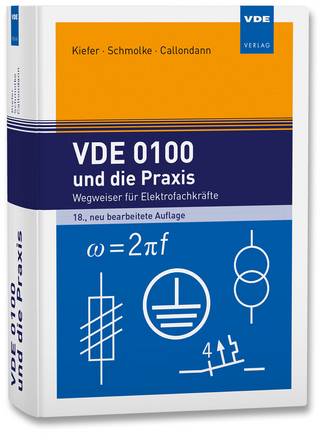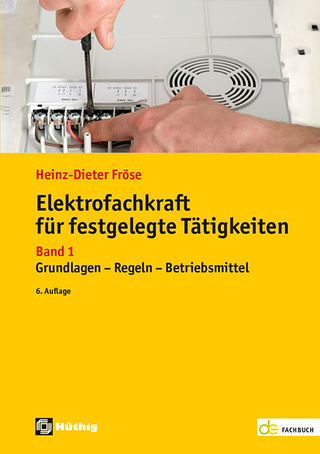
The Electric Generators Handbook - 2 Volume Set
Crc Press Inc (Verlag)
978-0-8493-1481-0 (ISBN)
- Titel ist leider vergriffen;
- Artikel merken
The modern world hungers for electricity. Traditionally, this hunger was sated with predominantly constant-speed-regulated, synchronous generators. However, new demands require the stable, quick, and efficient delivery and control offered by variable-speed generators.
Surveying all of the technologies used to satisfy the world's demand for open, efficient, and clean electricity, The Electric Generators Handbook, Two-Volume Set provides the first unified, in-depth examination of both synchronous and variable-speed generators for stand-alone and grid-connected applications. Individually, each book offers authoritative, tightly focused treatment that is ideal for specialists. Together, they offer the most complete reference available on the topologies, steady state and transients modeling, performance, control, design, and testing of stand-alone and grid-connected generators.
The two-volume design of this handbook combines unmatched comprehensiveness with the finely tuned attention and convenient size of a specialized monograph. This combination offers maximum ease of use and versatility, allowing you to choose the coverage best suited to your individual needs. The set comes packaged in a protective slipcase, or each volume may be purchased individually. Together or separately, you are sure to find the information you need in…
Synchronous Generators
The first of two volumes, Synchronous Generators offers a thorough introduction to electrical energy and electricity generation, including the basic principles of electric generators. The book devotes a chapter to the most representative prime mover models for transients used in active control of various generators. Then, individual chapters explore the topologies and steady state of large and medium-power synchronous generators; modeling and transients; control in power systems; design, including simple cases; and testing. Numerous examples, sample results, and illustrations highlight the concepts.
Variable Speed Generators
The second of two volumes, Variable Speed Generators thoroughly covers all types of variable-speed generators currently in progress in distributed generation and renewable energy applications around the world. It delves into the steady state, transients, control, and design of claw-pole rotor synchronous, induction, permanent magnet-assisted synchronous, and switched reluctance starter alternators for hybrid-electric vehicles. It also discusses PM synchronous, transverse-flux PM, and flux-reversal PM generators for low-speed wind and hydro energy conversion as well as linear motion alternators for residential and spacecraft applications. Numerous design and control examples illustrate the discussion.
The promise of renewable, sustainable energy rests on our ability to design innovative power systems that are able to harness energy from a variety of sources. Reflecting the latest technologies and deployments from around the world, The Electric Generators Handbook, Two-Volume Set supplies the tools necessary to design, validate, and deploy the right power generation technologies to fulfill tomorrow's complex energy needs.
Volume 1: Synchronous Generators
ELECTRIC ENERGY AND ELECTRIC GENERATORS
Introduction
Major Energy Sources
Electric Power Generation Limitations
Electric Power Generation
From Electric Generators to Electric Loads
Summary
References
PRINCIPLES OF ELECTRIC GENERATORS
The Three Types of Electric Generators
Synchronous Generators
Permanent Magnet Synchronous Generators
The Homopolar Synchronous Generator
Induction Generator
The Wound Rotor (DFIG) Doubly-Fed Induction Generator
Parametric Generators
Electric Generator Applications
Summary
References
PRIME MOVERS
Introduction
Steam Turbines
Steam Turbine Modeling
Speed Governors for Steam Turbines
Gas Turbines
Diesel Engines
Stirling Engines
Hydraulic Turbines
Wind Turbines
Summary
References
LARGE AND MEDIUM POWER SYNCHRONOUS GENERATORS: TOPOLOGIES AND STEADY STATE
Introduction
Construction Elements
Excitation Magnetic Field
The Two-Reaction Principle of Synchronous Generators
The Armature Reaction Field and Synchronous Reactances
Equations for Steady State with Balanced Load
The Phasor Diagram
Inclusion of Core Losses in the Steady-State Model
Autonomous Operation of Synchronous Generators
Synchronous Generator Operation at Power Grid (in Parallel)
Unbalanced-Load Steady-State Operation
Measuring Xd, Xq, Z, Z0
The Phase-to-Phase Short-Circuit
The Synchronous Condenser
Summary
References
SYNCHRONOUS GENERATORS: MODELING FOR (AND) TRANSIENTS
Introduction
The Phase-Variable Model
The d-q Model
The Operational Parameters
Electromagnetic Transients
The Sudden Three-Phase Short-Circuit from No Load
Standstill Time Domain Response Provoked Transients
Standstill Frequency Response
Asynchronous Running
Simplified Models for Power System Studies
Mechanical Transients
Small Disturbance Electromechanical Transients
Large Disturbance Transients Modeling
Finite Element SG Modeling
SG Transient Modeling for Control Design
Summary
References
CONTROL OF SYNCHRONOUS GENERATORS IN POWER SYSTEMS
Introduction
Speed Governing Basics
Time Response of Speed Governors
Automatic Generation Control (AGC)
Time Response of Speed (Frequency) and Power Angle
Voltage and Reactive Power Control Basics
The Automatic Voltage Regulation (AVR) Concept
Exciters
Exciter's Modeling
Basic AVRs
Underexcitation Voltage
Power System Stabilizers
Coordinated AVR-PSS and Speed Governor Control
FACTS-Added Control of SG
Subsynchronous Oscillations
Subsynchronous Resonance
Summary
References
DESIGN OF SYNCHRONOUS GENERATORS
Introduction
Specifying Synchronous Generators for Power Systems
Output Power Coefficient and Basic Stator Geometry
Number of Stator Slots
Design of Stator Winding
Design of Stator Core
Salient-Pole Rotor Design
Damper Cage Design
Design of Cylindrical Rotors
The Open-Circuit Saturation Curve
The On-Load Excitation mmf F1n
Inductances and Resistances
Excitation Winding Inductances
Damper Winding Parameters
Solid Rotor Parameters
SG Transient Parameters and Time Constants
Electromagnetic Field Time Harmonics
Slot Ripple Time Harmonics
Losses and Efficiency
Exciter Design Issues
Optimization Design Issues
Generator/Motor Issues
Summary
References
TESTING OF SYNCHRONOUS GENERATORS
Acceptance Testing
Testing for Performance (Saturation Curves, Segregated Losses, Efficiency)
Excitation Current under Load and Voltage Regulation
The Need for Determining Electrical Parameters
Per Unit Values
Tests for Parameters under Steady State
Tests to Estimate the Subtransient and Transient Parameters
Subtransient Reactances from Standstill Single-Frequency AC Tests
Standstill Frequency Response Tests (SSFRs)
Online Identification of SG Parameters
Summary
References
Volume 2: Variable Speed Generators
WOUND ROTOR INDUCTION GENERATORS (WRIGS): STEADY STATE
Introduction
Construction Elements
Steady-State Equations
Equivalent Circuit
Phasor Diagrams
Operation at the Power Grid
Autonomous Operation of WRIG
Operation of WRIG in the Brushless Exciter Mode
Losses and Efficiency of WRIG
Summary
References
WOUND ROTOR INDUCTION GENERATORS: TRANSIENTS AND CONTROL
Introduction
The WRIG Phase Coordinate Model
The Space-Phasor Model of WRIG
Space-Phasor Equivalent Circuits and Diagrams
Approaches to WRIG Transients
Static Power Converters for WRIGs
Vector Control of WRIG at Power Grid
Direct Power Control (DPC) of WRIG at Power Grid
Independent Vector Control of Positive and Negative Sequence
Motion-Sensorless Control
Vector Control in Stand-Alone Operation
Self-Starting, Synchronization, and Loading at the Power Grid
Voltage and Current Low-Frequency Harmonics of WRIG
Summary
References
WOUND ROTOR INDUCTION GENERATORS (WRIGS): DESIGN AND TESTING
Introduction
Design Specifications: An Example
Stator Design
Rotor Design
Magnetization Current
Reactances and Resistances
Electrical Losses and Efficiency
Testing of WRIGs
Summary
References
SELF-EXCITED INDUCTION GENERATORS
Introduction
The Cage Rotor Induction Machine Principle
Self-Excitation: A Qualitative View
Steady-State Performance of Three-Phase SEIGs
Performance Sensitivity Analysis
Pole Changing SEIGs for Variable Speed Operation
Unbalanced Operation of Three-Phase SEIGs
One Phase Open at Power Grid
Three-Phase SEIG with Single-Phase Output
Two-Phase SEIGs with Single-Phase Output
Three-Phase SEIG Transients
Parallel Connection of SEIGs
Connection Transients in Cage Rotor Induction Generators at Power Grid
More on Power Grid Disturbance Transients in Cage Rotor Induction Generators
Summary
References
STATOR CONVERTER CONTROLLED INDUCTION GENERATOR (SCIG)
Introduction
Grid Connected SCIGs: The Control System
Grid Connection and Four-Quadrant Operation of SCIGs
Stand-Alone Operation of SCIG
Parallel Operation of SCIGs
Static Capacitor Exciter Stand-Alone IG for Pumping Systems
Operation of SCIGs with DC Voltage Controlled Output
Dual Stator Winding for Grid Applications
Summary
References
AUTOMOTIVE CLAW-POLE-ROTOR GENERATOR SYSTEMS
Introduction
Construction and Principle
Magnetic Equivalent Circuit (MEC) Modeling
Three-Dimensional Finite Element Method (3D FEM) Modeling
Losses, Efficiency, and Power Factor
Design Improvement Steps
The Lundell Starter/Generator for Hybrid Vehicles
Summary
References
INDUCTION STARTER/ALTERNATORS (ISAS) FOR ELECTRIC HYBRID VEHICLES (EHVS)
EHV Configuration
Essential Specifications
Topology Aspects of Induction Starter/Alternator (ISA)
ISA Space-Phasor Model and Characteristics
Vector Control of ISA
DTFC of ISA
ISA Design Issues for Variable Speed
Summary
References
PERMANENT-MAGNET-ASSISTED RELUCTANCE SYNCHRONOUS STARTER/ALTERNATORS FOR ELECTRIC HYBRID VEHICLES
Introduction
Topologies of PM-RSM
Finite Element Analysis
The d-q Model of PM-RSM
Steady-State Operation at No Load and Symmetric Short-Circuit
Design Aspects for Wide Speed Range Constant Power Operation
Power Electronics for PM-RSM for Automotive Applications
Control of PM-RSM for EHV
State Observers without Signal Injection for Motion Sensorless Control
Signal Injection Rotor Position Observers
Initial and Low Speed Rotor Position Tracking
Summary
References
SWITCHED RELUCTANCE GENERATORS AND THEIR CONTROL
Introduction
Practical Topologies and Principles of Operation
SRG(M) Modeling
The Flux/Current/Position Curves
Design Issues
PWM Converters for SRGs
Control of SRG(M)s
Direct Torque Control of SRG(M)
Rotor Position and Speed Observers for Motion-Sensorless Control
Output Voltage Control in SRG
Summary
References
PERMANENT MAGNET SYNCHRONOUS GENERATOR SYSTEMS
Introduction
Practical Configurations and Their Characterization
Airgap Field Distribution, emf and Torque
Stator Core Loss Modeling
The Circuit Model
Circuit Model of PMSG with Shunt Capacitors and AC Load
Circuit Model of PMSG with Diode Rectifier Load
Utilization of Third Harmonic for PMSG with Diode Rectifiers
Autonomous PMSGs with Controlled Constant Speed and AC Load
Grid-Connected Variable-Speed PMSG System
The PM Genset with Multiple Outputs
Super-High-Speed PM Generators: Design Issues
Super-High-Speed PM Generators: Power Electronics Control Issues
Design of a 42 Vdc Battery-Controlled-Output PMSG System
Methods for Testing PMSGs
Note on Medium Power Vehicular Electric Generator Systems
Summary
References
TRANSVERSE FLUX AND FLUX REVERSAL PERMANENT MAGNET GENERATOR SYSTEMS
Introduction
The Three-Phase TFM: Magnetic Circuit Design
TFM: The d-q Model and Steady State
The Three-Phase Flux Reversal Permanent Magnet Generator: Magnetic and Electric Circuit Design
Summary
References
LINEAR MOTION ALTERNATORS (LMAS)
Introduction
LMA Principle of Operation
PM-LMA with Coil Mover
Multipole LMA with Coil Plus Iron Mover
PM-Mover LMAs
The Tubular Homopolar PM Mover Single-Coil LMA
The Flux Reversal LMA with Mover PM Flux Concentration
PM-LMAs with Iron Mover
The Flux Reversal PM-LMA Tubular Configuration
Control of PM-LMAs
Progressive-Motion LMAs for Maglevs with Active Guideway
Summary
References
| Erscheint lt. Verlag | 16.11.2005 |
|---|---|
| Reihe/Serie | Power Engineering |
| Zusatzinfo | 300 Illustrations, black and white |
| Verlagsort | Bosa Roca |
| Sprache | englisch |
| Maße | 178 x 254 mm |
| Gewicht | 2313 g |
| Themenwelt | Technik ► Elektrotechnik / Energietechnik |
| ISBN-10 | 0-8493-1481-X / 084931481X |
| ISBN-13 | 978-0-8493-1481-0 / 9780849314810 |
| Zustand | Neuware |
| Informationen gemäß Produktsicherheitsverordnung (GPSR) | |
| Haben Sie eine Frage zum Produkt? |
aus dem Bereich


